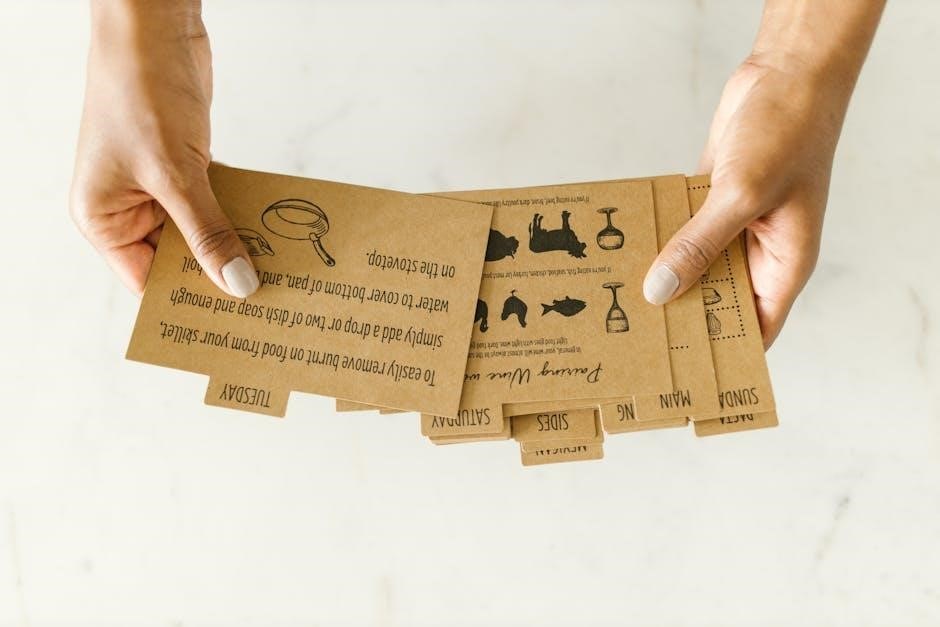clipper guide
A clipper is a versatile tool for grooming‚ styling‚ and trimming hair. This guide provides insights‚ tips‚ and techniques for mastering clippers‚ helping you achieve professional results easily.
1.1 What is a Clipper?
A clipper is an electrical grooming tool used for cutting‚ trimming‚ and styling hair. It typically features adjustable blades‚ allowing users to achieve various lengths and styles. Clippers are versatile‚ suitable for both personal and professional use‚ and come in corded or cordless designs. They are commonly used for haircuts‚ beard trimming‚ and pet grooming. Key features include interchangeable guards‚ ergonomic designs‚ and powerful motors for smooth cutting. Whether for home or salon use‚ clippers are essential tools for maintaining neat and precise grooming.
1.2 Importance of Using Clippers
Using clippers is essential for maintaining neat‚ precise haircuts and grooming. They offer precision‚ control‚ and versatility‚ making them ideal for both personal and professional use. Clippers promote hygiene by allowing easy cleaning and sanitization. Regular use can save time and money compared to frequent salon visits. They also enable customization‚ catering to individual styles and preferences. Whether for fades‚ trims‚ or detailed styling‚ clippers are indispensable tools for achieving professional-grade results at home or in a salon setting.
1.3 Brief History of Clippers
The origins of clippers date back to ancient civilizations‚ where rudimentary tools were used for grooming. In the late 1800s‚ the first mechanical clippers were developed‚ marking the beginning of modern grooming tools. The invention of the first electric clipper by Leo J. Wahl in 1919 revolutionized the industry‚ offering greater efficiency and precision. Over time‚ clippers evolved with advancements in technology‚ materials‚ and design‚ becoming essential for barbers and home users alike. Today‚ clippers are a cornerstone of grooming culture‚ offering versatility and convenience for various hairstyles and trimming needs.

Types of Clippers
Clippers come in various styles‚ catering to different needs. From corded to cordless‚ and specialty clippers‚ each type offers unique features for precise trimming and styling.
2.1 Corded Clippers
Corded clippers provide consistent power and performance‚ making them ideal for heavy use. They are typically more durable and offer precise control‚ especially in professional settings. With a constant power supply‚ they maintain optimal speed and efficiency; Often preferred by barbers for their reliability‚ corded clippers are designed for extended use without overheating. They are easy to maneuver and come with adjustable settings for various hair types. However‚ the cord may limit mobility‚ requiring a nearby power source. Overall‚ corded clippers remain a popular choice for their dependability and superior cutting capabilities.
2.2 Cordless Clippers
Cordless clippers offer unmatched convenience and portability‚ making them ideal for both professionals and home users. Powered by rechargeable batteries‚ they provide excellent mobility without the constraint of a cord. Lightweight and ergonomic‚ cordless clippers reduce fatigue during extended use. They often feature adjustable settings to cater to different hair types and styles. While they may lack the consistent power of corded clippers‚ advancements in battery technology have significantly improved their performance. Cordless clippers are perfect for travel or mobile grooming‚ offering flexibility and ease of use. However‚ they require regular charging to maintain optimal functionality.
2.3 Specialty Clippers
Specialty clippers are designed for specific grooming tasks‚ offering unique features for precise results. They include curved blades for fades‚ extra-wide blades for bulk hair‚ or adjustable tapered blades for detailed work. These clippers cater to specific hair types or styles‚ such as ultra-close cuts or textured designs. Often used by professionals‚ they provide superior control and accuracy. While they may require more skill‚ specialty clippers are essential for achieving advanced styles. They are a must-have for those seeking versatility and precision in their grooming toolkit‚ making them a valuable addition for both professionals and dedicated home users.

Choosing the Right Clipper
Selecting the right clipper is essential for achieving the desired grooming results. Consider your personal needs‚ hair type‚ and intended use to find the best fit.
3.1 Factors to Consider
When selecting clippers‚ consider factors like corded or cordless operation‚ blade type‚ and motor power. Think about your hair texture—thick‚ thin‚ curly‚ or straight. If you plan to use them frequently‚ ergonomics and comfort are crucial. Budget is another key factor; clippers vary widely in price. Additionally‚ consider the noise level‚ especially for home use. Durability and brand reputation should also influence your decision. Assessing these elements will help you choose clippers that meet your specific needs and preferences‚ ensuring a satisfying and effective grooming experience. Take your time to evaluate each factor carefully.
3.2 Blade Types and Uses
Clipper blades vary in type and purpose‚ catering to different grooming needs. High-carbon steel blades are durable and ideal for precision cuts‚ while stainless steel blades are rust-resistant and suitable for sensitive skin. Ceramic blades are sharp‚ reducing heat buildup‚ and are best for fine or curly hair. Adjustable blades offer versatility‚ allowing you to switch between lengths without changing blades. Detachable blades are easy to clean and replace. Choosing the right blade depends on your hair type‚ desired style‚ and personal preference. Proper blade selection ensures better performance and a more satisfying grooming experience‚ making it a critical decision for optimal results.
3;3 Ergonomics and Comfort
Ergonomics and comfort are crucial when selecting clippers‚ especially for extended use. Look for clippers with contoured handles‚ balanced designs‚ and non-slip grips to reduce fatigue and improve control. Lightweight models minimize strain‚ while cushioned handles enhance comfort. Ergonomic clippers are designed to fit naturally in the hand‚ ensuring precise maneuverability. For professionals‚ comfort is vital to maintain performance during long sessions. Prioritizing ergonomics ensures a better user experience‚ reduces the risk of discomfort‚ and allows for more accurate cuts. A comfortable clipper not only boosts efficiency but also delivers superior results‚ making it a key consideration for both home and professional use.

Maintenance and Care
Regular maintenance and care are essential for clippers to ensure optimal performance and longevity. This includes cleaning‚ lubrication‚ and proper storage to maintain efficiency and extend lifespan.
4.1 Cleaning Clippers
Cleaning clippers is crucial for maintaining hygiene and performance. Start by brushing off loose hair with a cleaning brush. Dampen a cloth with mild detergent and gently wipe the blades and exterior. For deeper cleaning‚ dip a cotton swab in a disinfectant solution and carefully clean between blades and teeth. Avoid harsh chemicals or submerging electrical parts in water. Regular cleaning prevents rust‚ reduces germ buildup‚ and ensures precise cuts. Sanitize after every use‚ especially if shared‚ to maintain safety and extend the life of your clippers.
4.2 Lubricating Clippers
Lubricating clippers is essential for maintaining smooth operation and extending their lifespan. Apply a few drops of clipper oil to the blades after cleaning. Gently run the clippers to distribute the oil evenly. Repeat this process every 1-2 weeks or as recommended by the manufacturer. Excess oil can attract dust‚ so use it sparingly. Regular lubrication prevents rust‚ reduces friction‚ and ensures precise cutting performance. Always check the manufacturer’s guidelines for specific lubrication instructions. Proper maintenance keeps your clippers in optimal condition‚ enhancing their efficiency and longevity.
4.3 Storing Clippers
Proper storage is crucial for maintaining your clippers’ performance and longevity. Store them in a hard case or protective pouch to shield against dust and damage. Clean and dry the clippers thoroughly before storing to prevent rust or corrosion. Keep them in a cool‚ dry place away from direct sunlight and moisture. Avoid storing clippers in humid environments or extreme temperatures. Store blades and guards separately if possible‚ and ensure they are securely packed. This prevents accidental damage and keeps your clippers ready for their next use. Regularly check stored clippers for dust or debris buildup.

Safety Precautions
Always handle clippers with care‚ keep them out of children’s reach‚ and ensure the area is clear of distractions. Follow proper techniques and guidelines to avoid accidents.
5.1 Pre-Use Safety Checks
Before using clippers‚ inspect the blades for sharpness and damage. Ensure cords are free from frays and plugs are secure. Lubricate blades if necessary and clean them thoroughly. Check the temperature of the clippers to avoid burns. Use guard attachments to prevent skin contact with the blades. Keep the area clear of obstructions like loose clothing or jewelry. Always test clippers on a small section first to ensure proper function. Store clippers out of children’s reach and avoid using them near water or in humid environments.
5.2 Safe Handling Techniques
Hold clippers firmly with a steady grip‚ keeping your hands dry and away from the blades. Start at the bottom of the hairline and work upwards with smooth‚ even strokes. Avoid applying excessive pressure‚ which can cause discomfort or nicks. Use a mirror for visibility and maintain good posture to prevent fatigue. Keep the clippers at a slight angle to prevent pulling hair. Never touch the blades with your fingers or other objects while in use. If the clippers vibrate excessively‚ stop and check for imbalances or loose parts. Always keep the cutting area well-lit for precision and safety.
5.3 Post-Use Care
After use‚ turn off the clippers and unplug them to begin post-use care. Clean the blades thoroughly with a brush or cloth to remove hair clippings. Sanitize the blades with a disinfectant solution to maintain hygiene. Dry the blades completely to prevent rust and store them in a protective case. Regular lubrication of the blades and motor ensures smooth operation. Proper post-use care extends the lifespan of your clippers and ensures they remain in optimal condition for future use. Always follow the manufacturer’s guidelines for maintenance and storage to preserve performance and longevity.

Using Clippers Effectively
Using clippers effectively requires proper preparation‚ technique‚ and understanding of their features. Always start with clean‚ dry hair and use the right blade size for desired results. Maintain steady control‚ work in small sections‚ and follow the natural hair grain to avoid uneven cuts. Regularly check blade alignment and tension to ensure optimal performance. Practice makes perfect—mastering the basics leads to professional-looking styles and efficient trimming sessions every time.
6.1 Preparing the Hair
Preparing the hair before using clippers is essential for a smooth and even cut. Start by washing and towel-drying the hair to remove dirt and oils. Use a comb or brush to detangle‚ ensuring no knots obstruct the clippers. Section the hair‚ especially around the ears and neck‚ to maintain clear access. Clip longer sections away if needed. For precise results‚ trim extremely long hair with scissors first. Always work on clean‚ dry hair for optimal blade performance. Proper preparation minimizes the risk of uneven cuts and ensures a professional finish. A well-prepared canvas leads to better clipping outcomes.
6.2 Basic Cutting Techniques
Mastering basic cutting techniques with clippers ensures consistent results. Begin by placing the clipper flat against the head‚ aligning the blade with the hair growth direction. Move the clippers in smooth‚ steady strokes‚ starting at the nape and working upwards. Use light pressure to avoid pulling hair. For evenness‚ overlap each stroke slightly. Maintain the same angle throughout to prevent unevenness. Use the clipper’s length guard to achieve uniformity. Always cut against the grain for closer trims. Practice these techniques to build confidence and achieve precise‚ professional-looking cuts every time. Consistency is key to mastering the fundamentals of clipper use.
6.3 Advanced Cutting Styles
Advanced cutting styles with clippers involve techniques like fading‚ tapering‚ and layering. Start by using different guard sizes to create gradients and seamless transitions. For a fade‚ hold the clipper at an angle and work in small sections‚ blending lengths gradually. Tapering requires precise blade control to create a natural finish. Layering involves cutting at varying angles to add texture and depth. Use the clipper’s edge for sharp lines and details. Practice adjusting blade angles and guard placements to achieve intricate designs. These techniques allow for personalized‚ professional-level styling‚ making every haircut unique and tailored to individual preferences.

Troubleshooting Common Issues
This section addresses common problems like jammed blades‚ overheating‚ and poor performance. Learn how to identify and fix issues quickly‚ ensuring your clippers work optimally.
7.1 Jammed Blades
Jammed blades are a common issue caused by hair and debris buildup. This can lead to poor cutting performance and even damage the clippers. To fix‚ turn off and unplug the device‚ then carefully remove the blades. Use a soft brush or cloth to clean out hair and dirt. For stubborn jams‚ lightly oil the blades and let them sit before wiping clean. Regular cleaning and lubrication can prevent jams. Always handle blades with care to avoid causing further damage; Proper maintenance ensures smooth operation and extends the lifespan of your clippers.
7.2 Overheating Clippers
Overheating clippers can occur due to prolonged use‚ blocked airflow‚ or dull blades. If your clippers feel excessively hot or emit a burning smell‚ stop use immediately. Allow them to cool down before resuming. Ensure proper ventilation by cleaning the vents and grille regularly. Lubricating the blades can also help reduce friction and heat buildup. For severe cases‚ consider replacing worn or damaged blades. Taking regular breaks during use and maintaining your clippers well can prevent overheating. Always prioritize safety to avoid damage to the device or potential burns.
7.3 Poor Cutting Performance
Poor cutting performance can result from dull or damaged blades‚ incorrect blade angles‚ or improper tension settings. Regularly sharpen or replace blades to ensure sharp cuts. Clean blades from hair clippings and debris‚ as buildup can hinder performance. Check for misaligned blades and adjust or replace them if necessary. Using the wrong blade type for the job can also lead to subpar results. Always maintain proper blade tension and consider lubricating moving parts. Improper technique‚ such as cutting against the grain or applying too much pressure‚ can also affect performance. Ensure clippers are well-maintained and used correctly for optimal results.

Clipper Accessories
Clipper accessories enhance functionality and longevity‚ including replacement blades‚ guard sizes‚ cleaning brushes‚ and storage cases. These essentials ensure optimal performance‚ hygiene‚ and organization for your grooming needs.
8.1 Blades and Guards
Blades and guards are essential clipper accessories. Blades‚ made from durable materials like stainless steel or ceramic‚ ensure precise cuts and longevity. Guards‚ available in various sizes‚ allow for adjustable cutting lengths‚ enabling uniform trims. Regular maintenance‚ such as cleaning and storing‚ extends their lifespan. Always choose blades and guards compatible with your clipper model for optimal performance. High-quality options enhance cutting efficiency and comfort‚ making them indispensable for both home and professional use. Proper care ensures consistent results and prevents damage to the clippers or hair.
8.2 Cleaning Brushes
Cleaning brushes are indispensable for maintaining clipper hygiene and functionality. Typically made of soft or stiff bristles‚ they effectively remove loose hair and debris from blades and guards. Regular use prevents clogs and ensures optimal performance. For best results‚ brush after every use to eliminate trapped hair. Stiff-bristle brushes are ideal for heavy-duty cleaning‚ while soft-bristle brushes are better for delicate or fine areas. Cleaning brushes also help extend the lifespan of clippers by preventing dust and oil buildup. Keep them sanitized and store in a dry place to maintain their effectiveness and longevity.
8.3 Storage Cases
Storage cases are essential for keeping clippers and their accessories organized‚ protected‚ and within easy reach. Durable materials like hard plastic or padded fabric ensure your clippers remain safe from scratches and damage. Many cases feature multiple compartments to store blades‚ guards‚ oils‚ and cleaning brushes‚ maintaining order and preventing loss. Proper storage extends the lifespan of your clippers by shielding them from dust and moisture. Portable storage cases are ideal for professionals who need to transport their tools. Invest in a high-quality case to preserve your investment and ensure your clippers remain in excellent condition for years to come.

Clipper Tips and Tricks
Mastering clippers involves technique‚ maintenance‚ and creativity. Discover expert advice for achieving precise cuts‚ minimizing noise‚ and extending blade longevity to enhance your grooming experience.
9.1 Achieving Even Cuts
To achieve even cuts‚ start by ensuring your clippers are well-maintained with sharp blades. Use the correct guard size for your desired length and maintain steady‚ even pressure. Begin at the base of the hair and work upward in small‚ consistent strokes. Avoid applying too much pressure‚ which can cause unevenness. After each pass‚ inspect your work and make adjustments as needed. Regularly cleaning and lubricating your clippers will also help maintain precision and consistency. Practice makes perfect‚ so take your time and focus on smooth‚ controlled movements for professional-looking results.
9.2 Reducing Noise
To reduce noise when using clippers‚ ensure they are well-lubricated‚ as dry blades can cause excessive vibrations. Regularly clean and maintain the blades to prevent friction. Use a lower speed setting when possible and consider investing in clippers designed for quieter operation. Dull blades can also increase noise‚ so keep them sharp. Proper handling and grip can minimize vibration transfer‚ making the experience quieter. Additionally‚ using a clipper with a dampening system or rubberized grips can help absorb noise. Regular maintenance and proper care will significantly reduce operational noise‚ ensuring a smoother and quieter trimming experience.
9.3 Extending Blade Life
Proper care is essential for extending the life of clipper blades. Regularly clean and lubricate them to prevent rust and reduce friction. Store blades in a dry place‚ away from direct sunlight‚ and avoid using harsh chemicals. Sharpen or replace dull blades promptly‚ as they can damage the clipper motor. Use the correct oil for lubrication and apply it sparingly. Avoid using blades on dirty or matted hair‚ as this can cause excessive wear. By following these tips‚ you can significantly extend the lifespan of your clipper blades and maintain optimal performance.

Clipper Reviews and Recommendations
Discover top-rated clippers for various needs‚ from home use to professional styling. Compare features‚ performance‚ and value to find the best clipper for your grooming requirements.
10.1 Best Clippers for Home Use
For home use‚ opt for clippers that balance ease of use and versatility. Cordless designs offer convenience‚ while adjustable blade lengths ensure precise cuts. Look for models with ergonomic grips‚ quiet operation‚ and durable construction. Key features include detachable blades‚ multiple guard sizes‚ and rechargeable batteries. Popular options often come with travel cases and cleaning kits. Consider clippers with safety features like rounded blade tips to prevent nicks. Affordable yet high-quality brands like Wahl‚ Andis‚ and Philips dominate the market‚ offering reliable performance for personal grooming needs.
10.2 Best Clippers for Professional Use
Professional clippers are designed for heavy-duty use‚ offering superior power‚ precision‚ and durability. Look for high-quality motors‚ sharp blades‚ and ergonomic designs to reduce fatigue during long sessions. Corded clippers are ideal for consistent power‚ while high-end cordless models provide unmatched convenience. Adjustable blade systems and advanced cooling features are essential for professional-grade performance. Top brands like Wahl‚ Andis‚ and Oster are favored for their reliability and versatility. These clippers often come with interchangeable blades‚ storage cases‚ and additional accessories‚ making them a worthwhile investment for barbers and stylists seeking precision and efficiency in their work.
10.3 Best Budget-Friendly Clippers
Budget-friendly clippers offer great value without sacrificing essential features. They are ideal for home use or professionals on a budget. Look for clippers with durable construction‚ adjustable blades‚ and quiet operation. Many affordable models include interchangeable guards and ergonomic designs for comfort. Brands like Wahl‚ Andis‚ and Remington offer cost-effective options that deliver reliable performance. These clippers are perfect for basic grooming needs‚ providing precise cuts and versatility at an affordable price. Investing in a budget-friendly clipper ensures you can achieve professional-like results without breaking the bank.
This guide provides comprehensive insights into clippers‚ from basics to advanced techniques. By following these tips‚ you can master clipper use‚ ensuring professional results every time.
11.1 Summary of Key Points
In this comprehensive guide‚ we explored the world of clippers‚ covering their history‚ types‚ and maintenance. We discussed how to choose the right clipper‚ essential safety precautions‚ and effective cutting techniques. Troubleshooting common issues‚ understanding accessories‚ and mastering tips for optimal performance were also highlighted. Whether for home or professional use‚ clippers are versatile tools that require care and skill. By following the advice in this guide‚ you can enhance your grooming experience and achieve consistently great results. Remember‚ proper maintenance and technique are key to long-lasting performance and satisfaction.
11.2 Final Tips for Clipper Users
To maximize your clipper experience‚ always prioritize proper maintenance and storage. Regularly clean and lubricate blades to ensure optimal performance. Practice cutting techniques on different hair types to build confidence. Invest in high-quality accessories like blades and guards for versatility. Keep clippers well-organized in a storage case to prevent damage. Stay updated with grooming trends and safety guidelines. For precise results‚ use the correct guard sizes and angles. Avoid overloading clippers with thick hair to maintain efficiency. Lastly‚ always follow safety precautions to prevent accidents and achieve professional-looking results at home or in the salon.
